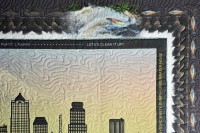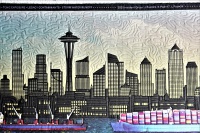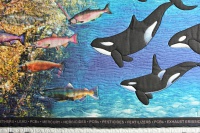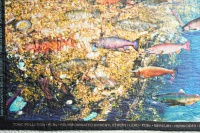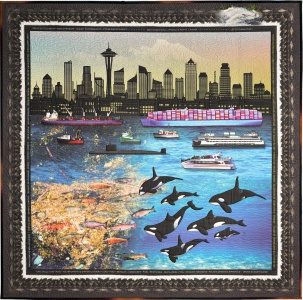 |
J Pod
Printable version
- Copyright © 2020 Caryl Bryer Fallert-Gentry
- Size: 41" x 41"
- Techniques: Digitally designed & painted, digitally printed, machine
quilted
- Fabric: 100% cotton / Batting: 50% cotton / 50% bamboo
- Price: $6400.00
See details & more information below
Larger image |
If
you would like to purchase or exhibit this quilt, please contact Caryl privately.
• Email • Phone: 360-385-2568 • Snail Mail: Bryerpatch Studio •10 Baycliff Place. • Port Townsend, WA 98368 |
 |
|
This quilt was made for a special exhibition of quilts about the effects of global warming and pollution. The most immediate effect in the area where we live, overlooking Puget Sound, is the decline in the resident orca population, or at least that’s what makes the news most often. The numbers have reached such low levels that experts fear that they will soon become extinct. The local orcas have their own culture, language, and dietary habits, and apparently have not interbred with the transients for at least 40,000 years. There seem to be many different reasons for the precipitous decline in their population. The ones mentioned most often in my reading are:
Water Pollution:
Toxic pollution in the water, which not only affects the health and fecundity of the orcas themselves, but also affects their food source. Unlike the transient orcas, which eat mammals (seals, dolphins, etc.), the residents only eat fish, mainly chinook salmon. Many of the worst toxins found in the tissues of the orcas are “legacy” chemicals like PCBs, which were outlawed in 1979, but still exist in electrical products and other construction products that can end up in landfills and then be carried into the seas by run-off. Orcas commonly live into their 60’s and have been known to live as long as 104 years, so the toxins have been accumulating for a long time. The females pass the toxins on to their babies, which may account for the scarcity of live births recently. Adding to the pollution of the seas is the run-off from vehicle emissions in the urban areas and air pollution carried into the water by rain. There are also some cities, like Victoria that discharge their sewage directly into the strait separating the Olympic Peninsula from Vancouver Island.
Plastic Pollution:
Plastic pollution poses a serious threat to whales, seals, turtles, salmon and all of Puget Sound’s wildlife. Single-use plastic bags, can choke, suffocate or kill whales, birds and other marine wildlife. A beached gray whale was found in West Seattle with 20 plastic bags in its stomach. Seattle has banned plastic shopping bags, straws, and flatware; however, these are still in use in other parts of the area. Our resident orcas also swim to the west side of the Olympic Peninsula, where plastic washed here, all the way from Asia, ends up in our local waters.
|
| |
Noise Pollution:
Noise pollution comes from the many vessels that sail through Puget Sound every day. Orcas locate their food by a kind of sonar, and the constant noise from container ships, ferries, cruise ships, military vessels, and yes, even whale watching ships may interfere.
Starvation:
Many of the orcas who have died recently are emaciated. They are not finding enough fish to sustain them. The salmon population suffers from pollution, over-fishing, diseases spread from fish farming facilities, and the damming of the rivers that are their traditional spawning grounds. The good news is that the dams on the Elwha river were removed several years ago, and the salmon are returning in record numbers. Unfortunately, that is just one small step and removing dams is not as simple as it may sound. The energy produced by the dams on the Snake River, (major problems for the salmon) are producing clean energy, which would have to be replaced by something else (possibly not so clean) if the dams were to be removed. The four dams on the lower Snake River in eastern Washington are part of a complex hydroelectric power system operated by the federal government in Washington, Oregon, Idaho and Montana. A federal study released at the end of February 2020 recommended that the dams remain in place.
Design:
Given this background I set out to design a quilt that illustrates why we need to be concerned. The design is a collage of photos and digital paintings assembled in Corel Draw on my Microsoft Surface Design computer, which allows me to draw and paint directly on the screen. The boat drawings, representing sound pollution, were inspired by my own photos and the photos of others. A license for the drawing of the Seattle skyline was purchased from iStock Photo. The photos of water were taken on a recent cruise to Southeast Asia. As we were sailing in the middle of the Bay of Bengal, I looked over the railing and saw a vast sea of floating plastic garbage. I just grabbed my camera and pointed it down over the railing to get the shot of the plastic pollution, which, in this quilt, represents all forms of water pollution. The salmon are swimming into the pollution and disappearing. The toxic chemicals, unfortunately, cannot be seen, so they are listed on the inner border along with all the other factors leading to the decline in orca population. At the end of the list I have noted the numbers of Orcas left in our resident pods as of January 2020. A picture of the snowcapped Cascades, taken from the window of my studio, fills the sky behind the Seattle skyline. The repeating pattern in the border is a detail from a photo of one of the dams on the Snake River. The orcas and the fish were individually painted and were inspired by photos from various sources. I have illustrated my hope for a return of the salmon population by making an outer border of chinook salmon, which are barely visible at first and become more and more clear as they swim toward the upper left border. The breech in the top border represents the salmon returning happily to the Elwha River, a scene we would like to see more of.
The composite image was digitally printed by Spoonflower.
The machine quilting was done with many different colors of acrylic and polyester thread. The binding and backing fabrics are from two of my collections for Benartex.
- For the Love of Gaia, (invitational)
- University of Nebraska, Lincoln, NE, June 26 - November 29, 2020
- Birmingham UK Festival of Quilts, July 2021
- New England Quilt Museum, Lowell MA, Jan 28-April 9, 2022
- Quiltfest New England, Massmutual Center, Springfield, MA, August 11-13, 2022
- Photos, Pixels, & Pizzazz: Digital Quilts by Caryl Bryer Fallert-Gentry, Special exhibition, Road to California Quilters Conference, Ontario, CA, January 17-21, 2023
- Environments, Kavanagh Gallery of Fine Line Creative Arts Center, St. Charles, Illinois. March 30 – May 12, 2023
- Inspiration/Exploration, SAQA Regional Exhibition, Traveling 2024-27
- Sequim Museum & Arts, Sequim, WA, February 1, 2024 – March 31, 2024
- Allied Arts, Bellingham, WA, June 1-30, 2024
- Schack Art Center, Everett, WA, November 15, 2025 – January 7, 2026
|
Web Site Design by Caryl Bryer Fallert-Gentry © 1997-2022
All Rights Reserved
Bryerpatch Studio • 10 Baycliff Place • Port Townsend, WA • 98368 • USA
360-385-2568 • caryl@bryerpatch.com
•••••
Updated
02/17/2024
|


